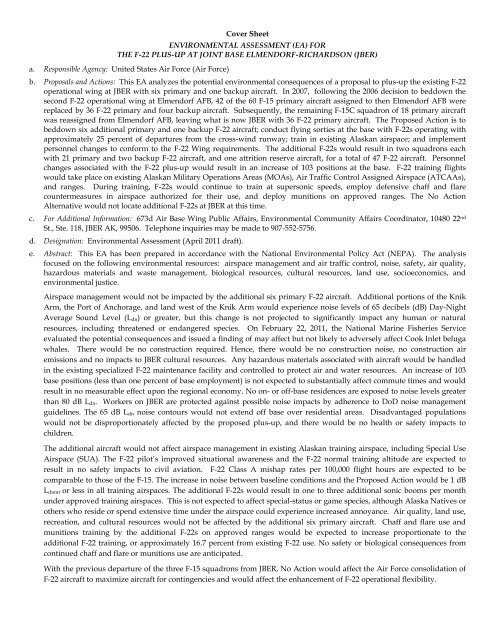F-22 Plus-Up Environmental Assessment - Joint Base Elmendorf ...
F-22 Plus-Up Environmental Assessment - Joint Base Elmendorf ...
F-22 Plus-Up Environmental Assessment - Joint Base Elmendorf ...
You also want an ePaper? Increase the reach of your titles
YUMPU automatically turns print PDFs into web optimized ePapers that Google loves.
Cover Sheet<br />
ENVIRONMENTAL ASSESSMENT (EA) FOR<br />
THE F-<strong>22</strong> PLUS-UP AT JOINT BASE ELMENDORF-RICHARDSON (JBER)<br />
a. Responsible Agency: United States Air Force (Air Force)<br />
b. Proposals and Actions: This EA analyzes the potential environmental consequences of a proposal to plus-up the existing F-<strong>22</strong><br />
operational wing at JBER with six primary and one backup aircraft. In 2007, following the 2006 decision to beddown the<br />
second F-<strong>22</strong> operational wing at <strong>Elmendorf</strong> AFB, 42 of the 60 F-15 primary aircraft assigned to then <strong>Elmendorf</strong> AFB were<br />
replaced by 36 F-<strong>22</strong> primary and four backup aircraft. Subsequently, the remaining F-15C squadron of 18 primary aircraft<br />
was reassigned from <strong>Elmendorf</strong> AFB, leaving what is now JBER with 36 F-<strong>22</strong> primary aircraft. The Proposed Action is to<br />
beddown six additional primary and one backup F-<strong>22</strong> aircraft; conduct flying sorties at the base with F-<strong>22</strong>s operating with<br />
approximately 25 percent of departures from the cross-wind runway; train in existing Alaskan airspace; and implement<br />
personnel changes to conform to the F-<strong>22</strong> Wing requirements. The additional F-<strong>22</strong>s would result in two squadrons each<br />
with 21 primary and two backup F-<strong>22</strong> aircraft, and one attrition reserve aircraft, for a total of 47 F-<strong>22</strong> aircraft. Personnel<br />
changes associated with the F-<strong>22</strong> plus-up would result in an increase of 103 positions at the base. F-<strong>22</strong> training flights<br />
would take place on existing Alaskan Military Operations Areas (MOAs), Air Traffic Control Assigned Airspace (ATCAAs),<br />
and ranges. During training, F-<strong>22</strong>s would continue to train at supersonic speeds, employ defensive chaff and flare<br />
countermeasures in airspace authorized for their use, and deploy munitions on approved ranges. The No Action<br />
Alternative would not locate additional F-<strong>22</strong>s at JBER at this time.<br />
c. For Additional Information: 673d Air <strong>Base</strong> Wing Public Affairs, <strong>Environmental</strong> Community Affairs Coordinator, 10480 <strong>22</strong> nd<br />
St., Ste. 118, JBER AK, 99506. Telephone inquiries may be made to 907-552-5756.<br />
d. Designation: <strong>Environmental</strong> <strong>Assessment</strong> (April 2011 draft).<br />
e. Abstract: This EA has been prepared in accordance with the National <strong>Environmental</strong> Policy Act (NEPA). The analysis<br />
focused on the following environmental resources: airspace management and air traffic control, noise, safety, air quality,<br />
hazardous materials and waste management, biological resources, cultural resources, land use, socioeconomics, and<br />
environmental justice.<br />
Airspace management would not be impacted by the additional six primary F-<strong>22</strong> aircraft. Additional portions of the Knik<br />
Arm, the Port of Anchorage, and land west of the Knik Arm would experience noise levels of 65 decibels (dB) Day-Night<br />
Average Sound Level (L dn) or greater, but this change is not projected to significantly impact any human or natural<br />
resources, including threatened or endangered species. On February <strong>22</strong>, 2011, the National Marine Fisheries Service<br />
evaluated the potential consequences and issued a finding of may affect but not likely to adversely affect Cook Inlet beluga<br />
whales. There would be no construction required. Hence, there would be no construction noise, no construction air<br />
emissions and no impacts to JBER cultural resources. Any hazardous materials associated with aircraft would be handled<br />
in the existing specialized F-<strong>22</strong> maintenance facility and controlled to protect air and water resources. An increase of 103<br />
base positions (less than one percent of base employment) is not expected to substantially affect commute times and would<br />
result in no measurable effect upon the regional economy. No on- or off-base residences are exposed to noise levels greater<br />
than 80 dB L dn. Workers on JBER are protected against possible noise impacts by adherence to DoD noise management<br />
guidelines. The 65 dB L dn noise contours would not extend off base over residential areas. Disadvantaged populations<br />
would not be disproportionately affected by the proposed plus-up, and there would be no health or safety impacts to<br />
children.<br />
The additional aircraft would not affect airspace management in existing Alaskan training airspace, including Special Use<br />
Airspace (SUA). The F-<strong>22</strong> pilot’s improved situational awareness and the F-<strong>22</strong> normal training altitude are expected to<br />
result in no safety impacts to civil aviation. F-<strong>22</strong> Class A mishap rates per 100,000 flight hours are expected to be<br />
comparable to those of the F-15. The increase in noise between baseline conditions and the Proposed Action would be 1 dB<br />
L dnmr or less in all training airspaces. The additional F-<strong>22</strong>s would result in one to three additional sonic booms per month<br />
under approved training airspaces. This is not expected to affect special-status or game species, although Alaska Natives or<br />
others who reside or spend extensive time under the airspace could experience increased annoyance. Air quality, land use,<br />
recreation, and cultural resources would not be affected by the additional six primary aircraft. Chaff and flare use and<br />
munitions training by the additional F-<strong>22</strong>s on approved ranges would be expected to increase proportionate to the<br />
additional F-<strong>22</strong> training, or approximately 16.7 percent from existing F-<strong>22</strong> use. No safety or biological consequences from<br />
continued chaff and flare or munitions use are anticipated.<br />
With the previous departure of the three F-15 squadrons from JBER, No Action would affect the Air Force consolidation of<br />
F-<strong>22</strong> aircraft to maximize aircraft for contingencies and would affect the enhancement of F-<strong>22</strong> operational flexibility.
















